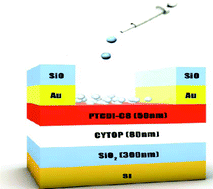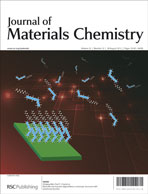Stable organic thin film transducers for biochemical and label-free sensing under physiological conditions†
Abstract
In this study we developed N,N′-dioctyl-3,4,9,10-perylenedicarboximide (PTCDI-C8)-based organic thin film transistors (OTFTs) for sensing applications in aqueous media. We converted an n-channel PTCDI-C8 into a stable device when a fluoropolymer (CYTOP) was positioned between the dielectric and the active layer. The resulting device was stable for up to 2000 h; its electron mobility (μ) improved to 0.29 ± 0.04 cm2 V−1 s−1 from 0.005 cm2 V−1 s−1 for the device lacking CYTOP, with the on/off ratio (Ion/Ioff) enhanced by one order of magnitude (from 103 to 104). By monitoring the shifts in drain current (IDS) and threshold voltage (Vth), we used these OTFTs as sensors for different concentrations of


 Please wait while we load your content...
Please wait while we load your content...